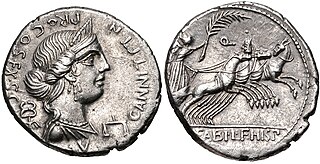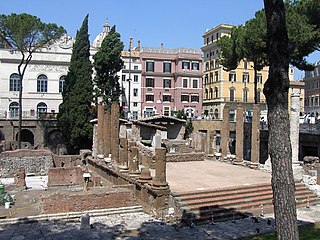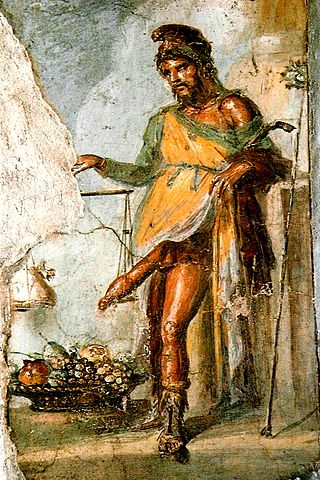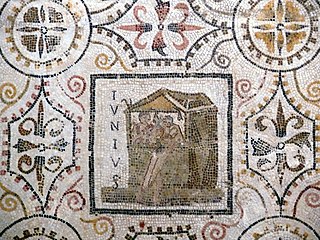
Anna Perenna was an old Roman deity of the circle or "ring" of the year, as indicated by the name.
In Roman mythology, Dea Tacita also known as Dea Muta or Muta Tacita was a goddess of the dead. Ovid's Fasti includes a passage describing a rite propitiating Dea Tacita in order to "seal up hostile mouths / and unfriendly tongue" at Feralia on 21 February. Dea Tacita is the same as the naiad Larunda. According to Ovid this occurred because Dea Tacita had her tongue ripped off by Jupiter. Jupiter was angry with her because she told the nymph Juturna to flee from him because he planned to rape her. In this guise, Dea Tacita was worshipped at a festival called Larentalia on 23 December. Goddesses Mutae Tacitae were invoked to destroy a hated person: in an inscription from Cambodunum in Raetia, someone asks "ut mutus sit Quartus" and "erret fugiens ut mus". Plutarch, who describes Tacita as a Muse, states that Numa Pompilius credited Tacita for his oracular insight and taught the Romans to worship her.

In the myth and religion of ancient Rome, Juturna, or Diuturna, was a goddess of fountains, wells and springs, and the mother of Fontus by Janus.

In ancient Roman religion and myth, Janus is the god of beginnings, gates, transitions, time, duality, doorways, passages, frames, and endings. He is usually depicted as having two faces. The month of January is named for Janus (Ianuarius). According to ancient Roman farmers' almanacs, Juno was mistaken as the tutelary deity of the month of January, but Juno is the tutelary deity of the month of June.

Festivals in ancient Rome were a very important part in Roman religious life during both the Republican and Imperial eras, and one of the primary features of the Roman calendar. Feriae were either public (publicae) or private (privatae). State holidays were celebrated by the Roman people and received public funding. Games (ludi), such as the Ludi Apollinares, were not technically feriae, but the days on which they were celebrated were dies festi, holidays in the modern sense of days off work. Although feriae were paid for by the state, ludi were often funded by wealthy individuals. Feriae privatae were holidays celebrated in honor of private individuals or by families. This article deals only with public holidays, including rites celebrated by the state priests of Rome at temples, as well as celebrations by neighborhoods, families, and friends held simultaneously throughout Rome.

The Floralia was a festival in ancient Roman religious practice in honor of the goddess Flora, held on 27 April during the Republican era, or 28 April in the Julian calendar. The festival included Ludi Florae, the "Games of Flora", which lasted for six days under the empire.

The Veneralia was an ancient Roman festival celebrated April 1 in honor of Venus Verticordia and Fortuna Virilis.

Juno was an ancient Roman goddess, the protector and special counsellor of the state. She was equated to Hera, queen of the gods in Greek mythology and a goddess of love and marriage. A daughter of Saturn and Ops, she was the sister and wife of Jupiter and the mother of Mars, Vulcan, Bellona, Lucina and Juventas. Like Hera, her sacred animal was the peacock. Her Etruscan counterpart was Uni, and she was said to also watch over the women of Rome. As the patron goddess of Rome and the Roman Empire, Juno was called Regina ("Queen") and was a member of the Capitoline Triad, centered on the Capitoline Hill in Rome, and also including Jupiter, and Minerva, goddess of wisdom.

Maia, in ancient Greek religion and mythology, is one of the Pleiades and the mother of Hermes, one of the major Greek gods, by Zeus, the king of Olympus.
Larunda was a naiad nymph, daughter of the river Almo and mother of the Lares Compitalici, guardians of the crossroads and the city of Rome. In Ovid's Fasti she is named Lara.
Ferālia was an ancient Roman public festival celebrating the Manes which fell on 21 February as recorded by Ovid in Book II of his Fasti. This day marked the end of Parentalia, a nine-day festival honoring the dead ancestors.

The strix, in the mythology of classical antiquity, was a bird of ill omen, the product of metamorphosis, that fed on human flesh and blood. It also referred to witches and related malevolent folkloric beings.

The Fasti, sometimes translated as The Book of Days or On the Roman Calendar, is a six-book Latin poem written by the Roman poet Ovid and published in AD 8. Ovid is believed to have left the Fasti incomplete when he was exiled to Tomis by the emperor Augustus in 8 AD. Written in elegiac couplets and drawing on conventions of Greek and Latin didactic poetry, the Fasti is structured as a series of eye-witness reports and interviews by the first-person vates with Roman deities, who explain the origins of Roman holidays and associated customs—often with multiple aetiologies. The poem is a significant, and in some cases unique, source of fact in studies of religion in ancient Rome; and the influential anthropologist and ritualist J.G. Frazer translated and annotated the work for the Loeb Classical Library series. Each book covers one month, January through June, of the Roman calendar, and was written several years after Julius Caesar replaced the old system of Roman time-keeping with what would come to be known as the Julian calendar.

In Greek mythology, Priapus is a minor rustic fertility god, protector of livestock, fruit plants, gardens, and male genitalia. Priapus is marked by his oversized, permanent erection, which gave rise to the medical term priapism. He became a popular figure in Roman erotic art and Latin literature, and is the subject of the often humorously obscene collection of verse called the Priapeia.

A liminal deity is a god or goddess in mythology who presides over thresholds, gates, or doorways; "a crosser of boundaries". These gods are believed to oversee a state of transition of some kind; such as, the old to the new, the unconscious to the conscious state, the familiar to the unknown.
In ancient Roman religion, the Fordicidia was a festival of fertility, held on the Ides of April, that pertained to farming and animal husbandry. It involved the sacrifice of a pregnant cow to Tellus, the ancient Roman goddess of the Earth, in proximity to the festival of Ceres (Cerealia) on April 19.

Roman mythology is the body of myths of ancient Rome as represented in the literature and visual arts of the Romans. One of a wide variety of genres of Roman folklore, Roman mythology may also refer to the modern study of these representations, and to the subject matter as represented in the literature and art of other cultures in any period. Roman mythology draws from the mythology of the Italic peoples and ultimately from Proto-Indo-European mythology.

Aprilis or mensis Aprilis (April) was the second month of the ancient Roman calendar, following Martius (March) and preceding Maius (May). On the oldest Roman calendar that had begun with March, Aprilis was the second of ten months in the year. April had 29 days on calendars of the Roman Republic, with a day added to the month during the reform in the mid-40s BC that produced the Julian calendar.

On the ancient Roman calendar, mensis Iunius or Iunius, also Junius (June), was the fourth month, following Maius (May). In the oldest calendar attributed by the Romans to Romulus, Iunius was the fourth month in a ten-month year that began with March (Martius, "Mars' month"). The month following June was thus called Quinctilis or Quintilis, the "fifth" month. Iunius had 29 days until a day was added during the Julian reform of the calendar in the mid-40s BC. The month that followed Iunius was renamed Iulius (July) in honour of Julius Caesar.















